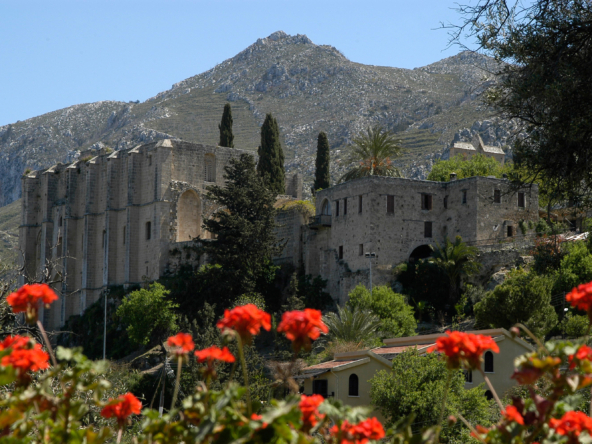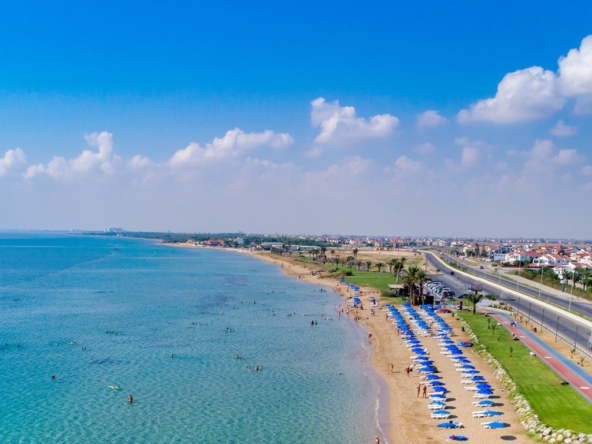Best Places To Visit in North Cyprus
North Cyprus has several beautiful sites to visit while on vacation. We have compiled a list of the TOP locations to see in North Cyprus that you should not miss.
Kyrenia Harbour

Kyrenia is known as the “Jewel of Cyprus” because of its magnificent harbor and neighboring castle. It is really magnificent! The town was most likely built about the tenth century BC and was one of the first city kingdoms. Its location on the north coast made it an ideal location for the development of a harbor, and it was just forty miles from the Turkish mainland, making it suitable for trade.
The harbour is bordered with flats, cafes, bars, and restaurants that offer a variety of wonderful places to eat where you may sample the local cuisine.
Kyrenia Castle

The Kyrenia Castle, located near to the Kyrenia Harbour, is a complex blend of architectural styles worth seeing in North Cyprus. Behind the Venetian castle walls, you’ll find St. George’s Church, royal apartments, Byzantie Chapel, and French dungeons.
The ship in the Shipwreck Museum is thought to have sunk around 300BC and is the oldest ship ever recovered from the seafloor.
Today, you enter the castle by the north-west corner and go along a lengthy ramp that leads to the castle’s central parade ground area. On the route, we pass a tomb that serves as the final resting place of an Ottoman admiral.
Guardrooms, residential quarters, and stables line the central courtyard, with more ramps leading to defenses on the higher sections of the walls. You can also ascend steps to the Lusignan royal quarters and the little chapel.
Dungeons, storage rooms, and the all-important’magazines’, where gunpowder was stored pure and dry, ready for use, may be found deep within the castle.
Bellapais Abbey

The Bellapais Abbey is without a doubt one of the most tranquil spots in North Cyprus. It was established at the start of the thirteenth century. The majority of the Bellapais Abbey that can be seen today dates from Hugh III’s reign.
It is a lovely and exquisite structure that has been built in Gothic styles at various stages. A machiocated gatehouse guards a small courtyard.
The location is also a museum with a restaurant and a cafe. The refectory of the Abbey is now used for concerts and lectures. It also serves as a location for a local music festival in the early summer.
Summer hours are 9 a.m. to 7 p.m.; winter hours are 9 a.m. to 1 p.m. and 2 p.m. to 4:45 p.m. From mid-September through May, the hours of operation are 9 a.m. to 5 p.m.
St. Hilarion Castle

The castle of St Hilarion is perched high in the Kyrenia mountain range, overlooking the Mediterranean and the surrounding lands of North Cyprus. The castle, said to be the inspiration for Walt Disney’s ‘Sleeping Beauty,’ is one of the best preserved of all the Crusader Castles, thanks largely to the efforts of the North Cyprus Antiquities Department.
The castle provides numerous chances for people interested in history as well as those seeking breathtaking views – on a clear day, you can see all the way to the Turkish mainland!
The castle is located approximately 670 meters from Kyrenia. It was named after a hermit who formerly lived on the peak. The castle was constructed on three storeys. The upper level is made up of winding and narrow steps leading up to Prince John’s Tower and the royal apartments. It has a beautiful view of Kyrenia and the nearby villages.
Buffavento Castle

The highest castle, at 954 meters, offers the most breathtaking view. A 6.8-kilometer drive along a difficult road is followed by a 45-minute hike up the mountain trail. It is an excellent architectural that should not be missed when visiting North Cyprus.
The most complete rooms are available for viewing on the lower level, and there is evidence of human living in the custodian’s quarters, when there was one long ago. It is now only used when there are workers at the castle maintaining the fabric of the buildings.
There is evidence of cisterns beneath the floors in some of the chambers, and some still contain water. Winter rains were the only source of water for drinking and cooking, and it was stored in deep subterranean reservoirs where it remained fresh for many years.
Salamis Ancient Ruins

Salamis is one of North Cyprus’s most important and fascinating locations. It was founded about the 12th century BC and had a long history until it was destroyed in the 7th century by Arab raiders, earthquakes, and tides. It is a big city full with Roman structures and architecture.
After a catastrophic earthquake damaged the city in 76 AD, Trajan and Hadrian built the Gymnasium with its colonnaded Palaestra. This is the most monumental part of the site, but the columns vary in size since, following the second big earthquake of 331 AD, Christians erected additional columns hauled from the Roman theater.
The second most striking sight is the theater, which has 50 rows of seats and a seating capacity of 15,000 people. There are several niches all around the excavated buildings that had marble statues, and those that can be seen are headless.
When Christianity was accepted as the state religion, all of these naked statues were despised and were thrown down drains or torn up. In fact, all evidence of Roman pagan worship, such as mosaic images, was disfigured or destroyed.
Karpaz Peninsula and Apostolos Andreas Monastery

The Karpaz peninsula, located in the north-east corner of North Cyprus, is a time capsule with miles and miles of unspoilt sandy beaches. The Apostolos Andreas Monastery, located near the extremity of the peninsula, is devoted to St Andrew, the miracle worker.
Karpaz is particularly well-known for its biodiversity, which includes wild donkeys. Visit Karpaz, one of North Cyprus’s most beautiful places.
According to the popular tale, the monastery was founded when the ship carrying Saint Andrew sailed off course and hit rocks here on his way to the Holy Land. When Andrew landed, he struck the rocks with his staff, causing a spring to shoot forth.
The waters proved to have therapeutic properties, and the ship’s captain, who had been blind in one eye, was able to regain his sight. Following then, the location became a pilgrimage site. In the 12th century, a fortified monastery was here, from which Isaac Komnenos negotiated his surrender to Richard the Lionheart.
The main monastery’s church comes from the 18th century, while the main buildings were built 100 years later.
Kantara Castle

The Byzantines built Kantara Castle in 965 to dominate the Karpaz peninsula after Arab incursions. It is the highest and most accessible, standing at 610 m. It was created around the complete situation of the mountain summit on which it was erected.
On clear days, it provides a spectacular view over the Karpaz peninsula and Salamis Bay, as well as Famagusta and other parts of North Cyprus.
Kantara is located to the east of the Buffavento Castle, with the St. Hilarion Castle even more to the west, forming a protective axis in Northern Cyprus’s Kyrenia mountain range. It was used to send communications between the two castles because both are visible from Buffavento.
St. Barnabas Monastery

The St. Barnabas Monastery near Famagusta is devoted to St. Barnabas, the patron saint of Cyprus. The church is now an icon museum, with a spectacular collection of Cypriot artifacts dating back to the 7th century BC maintained in the monks’ ancient cells.
Cyprus has had a number of kings with varying religious beliefs, ranging from Muslim to Christian and Pagan. Cultures have merged and crossed, resulting in an island of mixed religions, with churches and mosques coexisting. Cultures that revered the moon and stars gave way to those that revered pagan icons.
These, in turn, were succeeded by faiths that believed in God, and by the time the Romans took control of the island, Judaism had a large following.
The icon museum houses various artifacts, including one of North Cyprus’s best collections of Bronze Age and Early Iron Age antiquities. On-site, there is a modest gift shop and restaurant.
Don’t forget to pay a visit to the tomb! – St. Barnabas tomb is located about 100 yards from the monastery and was built on the site where his remains were discovered.
Lala Mustafa Pasha Mosque

The most remarkable structure in Famagusta is St Nicolas’ Cathedral. After being crowned as kings of Cyprus in Nicosia, Lusignan rulers were anointed as kings of Jerusalem here in absentia. The Ottomans converted the cathedral into a mosque and named it after the Ottoman General who invaded Cyprus.
The Lusignan family governed as Kings of Cyprus from 1192 to 1489, bringing with them the newest French architectural tastes, particularly innovations in Gothic architecture.
The cathedral, possibly designed by the Frenchman Jean Langlois and presumed to be erected over the ruins of an ancient church, was built from 1298 to 1312 and consecrated in 1328.
In 1372, the Lusignans were crowned as Kings of Cyprus in Nicosia’s St. Sophia Cathedral, and then as Kings of Jerusalem in Famagusta’s St. Nicholas Cathedral.
The Kyrenia Gate

The gate was built in 1567 as part of the new city walls by Venetians. The Ottomans renovated it in 1821, and an observation post was added to the gate in anticipation of a possible Greek insurrection.
The Nicosia Turkish Municipality now uses the gate as a tourism information office.
Selimiye Mosque

The Selimiye Mosque, formerly known as the Cathedral of Saint Sophia, is a former Roman Catholic cathedral that has been transformed into a mosque.
According to reports, it “may have been the largest church built in the Eastern Mediterranean throughout the millennium between the rise of Islam and the late Ottoman period.”
The cathedral’s name is derived from Ayia Sophia, which means “Holy Wisdom” in Greek. The cathedral’s devotion to the Holy Wisdom is a relic of the Byzantine cathedral that once stood in the same location.
Calm is felt when the Muezzin recites the Adhan, calling followers to daily prayer, echos through Nicosia’s small alleys.
St Mamas Church and Icon Museum

Mamas, according to local mythology, was a hermit who lived in a cave outside of town in exceedingly terrible conditions. When the authorities tried to tax him, he pretended to be poor and dodged them for a while.
Soldiers were dispatched to recover the levy and apprehended him at his home. Mammas escaped on the way back by jumping on the back of a furious lion attacking a lamb, and he rode it all the way into town while holding the injured lamb in his arms.
The Byzantine officials were so struck by this sight that they decided to spare him from paying taxes and penalty for the rest of his life. St. Mamas has been the Patron Saint of Tax Avoiders ever since! This Christian Saint is so revered on the island that there are over 10 churches dedicated to him.
Nonetheless, the beautiful collection of religious Icons, the excellent craftsmanship and craftwork spanning back many centuries, is well worth your attention.
Soli Ruins

Soli, one of the ten city kingdoms that comprised the island at the time, was most likely built in the 6th century BC. The Romans constructed the ruins that may be seen today. There is a theater, ruins of a 5th century basilica, mosaics, and the base of a fountain once dedicated to the Goddess Aphrodite. There are beautiful geometric designs or churdh on the southern aisle.
One of the basilica’s most notable treasures are the mosaics found in the flooring, the majority of which have survived to the present day.
Mosaics were originally of geometric form, as in other churches in Cyprus, but animal images such as birds and bulls were eventually integrated, and opus sectile decoration from little coloured stone tiles was later constructed.
The most recognizable and quickly draws visitors’ eye is the goose-like swan mosaic in the nave floor, surrounded by flowery and four little dolphins. The mosaic set’s inscription says, “Christ! “Mercy on those who made this mosaic.”





